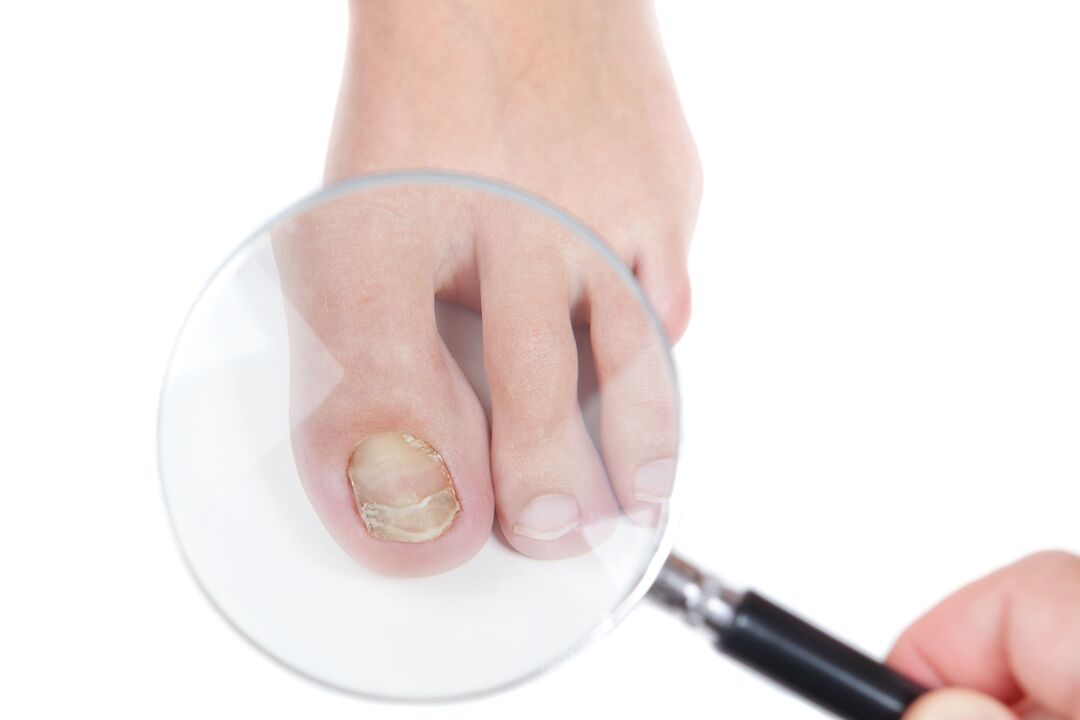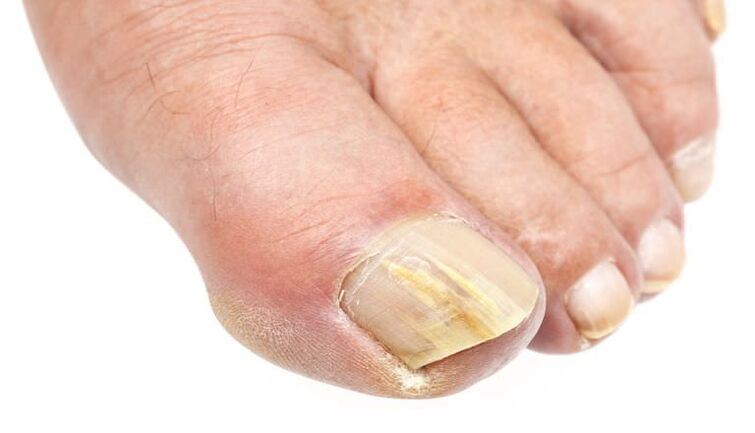Onychomycosis is a disease that gets infected quickly but is much harder to cure. It is not only a cosmetic problem, but it also causes unpleasant and painful sensations in the person. According to statistics, every 10 inhabitants of the planet suffer from it, and you may also be in the risk zone. What are the causes of the disease, the factors for the development of onychomycosis and how to defeat toenail fungus?
How does toenail fungus appear and why does it occur?
The disease is caused by dermatophytes, yeasts and molds. According to statistics, one in ten people on the planet is affected by this disease.

Where can you get nail fungus? The main risk areas are swimming pools, baths, saunas. You can become infected by wearing someone else's shoes, socks, or during a pedicure procedure. Onychomycosis most commonly affects individuals with chronic diseases such as obesity, diabetes, anemia, gastrointestinal, hormonal, immunological and cardiovascular disorders, and long-term treatments with steroids, antibacterials and chemotherapy.
Heat and humidity contribute to the development of spores. The main routes of infection are wounds, microfissures and other skin lesions in the area of the fingers. Ringworm develops when the nail plate is damaged - if we cut it quickly or break it, the fungus will easily penetrate its interior. Wearing tight shoes also weakens the fabric, as do acrylic, gel, and nail polish.
We do a diagnosis
Visual manifestations of the disease are already the second stage of the disease. The first evidence of infection - itchiness, burning - is usually attributed to excessive dryness of the skin, bad soap, a side effect of taking medication. Timely diagnosis and initiation of treatment allow you to get rid of the problem quickly and effectively.
How to diagnose the disease yourself
The main symptom is external changes, especially in the early stages of disease development. The first signs usually appear on the free edge (front) of the nail plate or on the sides. Early onychomycosis can be an unpleasant feeling during physical activity. Patients describe paresthesia (numbness), pain, discomfort and loss of fitness. Typical external changes include the following symptoms:
- discoloration - white, yellow, brown, greenish, gray spots appear on the tips of the nails;
- peeling and delamination of the fabric, its fragility is clearly reinforced;
- thickening of the stratum corneum, characteristic symptoms of excessive keratosis;
- unpleasant foot odor.

Fungal infections are more common on the legs than on the hands. They can be limited to one finger or cover all. However, the disease usually affects the first and fifth toes, due to the closer proximity of the shoes.
How the fungus is diagnosed in a medical clinic
The self-diagnosis method is not always effective as there are several diseases with a history similar to a fungal infection. These include:
- Psoriasis - it may look similar, but the characteristic of this disease is that it affects symmetrically. Typical signs are the appearance of white spots due to accumulations of air, redness of the hole, thimble syndrome (dents), loss of shine, roughness. In addition, the patient has typical skin lesions.
- Candidiasis. It is characterized by the appearance of purulent secretion, in addition to painful sensations when pressing on the affected area. The disease is more common in women, especially in people who often need to wear closed, airtight shoes in hot, humid environments. To develop this type, you need to have a finger injury in the nail area. Leakage: The plaque follicles swell, becoming very red and painful.
- Trophic changes caused by mechanical damage. The problem is usually concentrated in the proximal part of the plate (ie, its base).
- Lichen. It is characterized by typical lesions on the skin and mucous membranes. The lichen-affected blade is usually covered with yellowish-white streaks.
In addition, there are different types and forms of nail fungus, depending on the causative agent of the problem, the duration of the infection. The clinic determines the type of illness and prescribes a treatment regimen based on the tests performed.
treatment methods
Therapy for onychomycosis should be started immediately after detection of the problem. If you delay treatment, a complication can occur: infection of the neighboring fingers, the transition to a chronic form, and a progressive course of the disease. Therefore, always make an appointment with your doctor if you find any suspicious changes or use popular time-tested methods.
Popular Remedies for Fungus
<3_img_blockxx>In the early stages of the disease, home remedies work well to fight fungal infections. To get rid of fungus, you can try these recipes:
- Tea tree oil. The blend is a powerful natural antiseptic and fungicide. It is applied dropwise to the affected area 2 times a day. The course duration is 21 days.
- Apple vinegar. From it, prepare foot baths, mixing in equal parts with water.
- Fungus iodine. An old proven way to get rid of nail fungus. Method of application: once a day, apply 1-2 drops of the composition on the affected dish. To prevent infection of neighboring fingers, it is recommended to lubricate them with iodine, but less often - once every 2-3 days.
- Listerine mouthwash. It contains an antiseptic and a small amount of alcohol in its composition, which affect the treatment process.
- Lemon juice. It is applied as a compress for 30 minutes. to the affected areas.
A positive effect is given by dietary restrictions during treatment. Sweet and starchy foods should be excluded from the daily diet, and the amount of protein (meat, fish, poultry), dairy products (yoghurt, kefir, cottage cheese) should be increased. Fruits should also not be sugary (lemon, grapefruit, sour apples, raspberries, cherries). Diet is necessary to strengthen human immunity and reduce the concentration of the nutrient medium for the fungus - simple sugars that form in the body when consuming easily digestible carbohydrates.
Modern Remedies and Procedures
Unfortunately, home remedies for yeast infections are often ineffective. This is due to the fact that the disease has already gone into a progressive form. To get rid of it, you need to see a doctor. The effectiveness of medical therapy depends on the duration of the course, which takes several months, even after visual symptoms have been eliminated. But patients forget that they need to continue the course after the cosmetic effect occurs. This leads to relapse and the need for treatment right from the start.
In the early stages, when tissue changes are minor, a fungicidal ointment will help a lot. For advanced cases, oral medications are usually prescribed. Foot fungus is prone to relapse, so follow your doctor's recommendations after recovery. In general, the duration and order depend on the type of nail infection, the clinical course, the number of infected nails and the degree of plaque lesion. In some cases, a systematic approach that combines multiple methods is required. Combining systemic and local exposure improves the effectiveness of therapy.
Topical antifungal ointments
Topical medications should be used only in cases where the lesion occupies less than half of the distal part of the plaque and when the patient cannot tolerate systemic treatment. Ointments, suspensions include amorolfines, cyclopirox and bifonazole, urea. They are used daily for 5-12 months. The last option for the topical treatment of oncomycosis is bifonazole in combination with a 40% urea solution.
But external agents cannot help to heal completely, because they don't penetrate the tissues far enough. It was found that although the latest generation of ointments capture all layers, they still have low effectiveness when used as a single formulation. However, these agents can be useful as adjuvant therapy, complementing oral medications or to prevent relapses in patients who have already taken oral medications.
antifungal pills
Oral treatment for ringworm is almost always a necessity. New generations of antifungal drugs, such as itraconazole or terbinafine, have recently replaced older generics for nail care. The effectiveness of these funds is explained by their ability to penetrate the nail plate in just a few days after starting the course. By using them, you can have a shorter duration of therapy with a faster recovery rate and fewer side effects. Terbinafine (international name, you should look for commercial analogues in the pharmacy), fungicides (kill the pathogen) cure the disease and prevent the subsequent spread of spores. These drugs work with yeast viruses and dermatophytes, the most common causes of nail fungus.
Surgical treatment of onychomycosis
This method can also be used to treat fungal nail infections. It is a mechanical and chemical removal of the infected nail plate (using 40-50% urea). This is a painless and beneficial method when the growth is too thick and interferes with patient comfort.
Removal of the nail plate for onychomycosis should be considered as adjuvant therapy in patients receiving oral agents. The combination of oral, topical (lubricant) and surgical treatment of the fungus results in the fastest cure rate and is, at the same time, the cheapest option (fewer relapses, short course).
laser therapy
A new method that shows the greatest efficiency. In just 4 sessions of "cold" laser irradiation, you can completely get rid of the problem. The only disadvantage of this type of exposure is the relatively high cost of the procedures.
Prevention Principles
<4_img_blockxx>Once you find out what causes foot fungus, it's easier to avoid the disease. By following simple recommendations, you can avoid the problem. Basic rules to avoid fungi:
You must take care of your feet and keep them clean. After bathing procedures, it is advisable to treat the skin with cosmetics with an antiseptic effect. Wet shoes, after a day of wearing, should be dried until absolutely dry - you should not wear shoes even if they are slightly damp. If, despite the care taken, there are changes characteristic of the disease, a doctor should be consulted immediately.
























